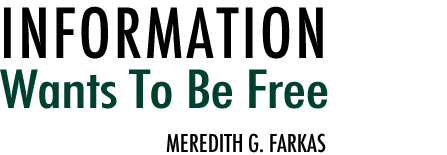Jason Clark (Montana State University) and Karen Coombs (University of Houston)
Incorporating Web 2.0 into Library Websites by Karen Coombs
Web 2.0 concepts –
- Radical decentralization – usually you have a Web manager who puts the content online. The University of Houston’s library has 1500 pages, so responsibilities for Web development needs to be decentralized. They developed a content management system to allow anyone on the library staff to update pages. Karen also integrated wikis and blogs into the library Web site.
- Small Pieces Loosely Joined – Website is a combination of different technologies that are modular and work well together. Different modules for news, resources, etc. Content is reusable throughout the site and anywhere else. A faculty member can grab a subject guide or a bibliography and put it into their courseware. Any piece of the CMS can be replaced as needed (rather than throwing the baby out with the bathwater).
- Perpetual beta – Deploy systems early and make constant improvements. She brought the wikis up in a month, had alpha testers on staff, got feedback, and made changes. It gets users involved in the development process. It allows you to get input and make continuous improvements. They started using Moveable Type for their blogs and are looking to move away from it. But because people are used to change now, the change will be less disruptive.
- Remixable content – APIs to allow content to be incorporated into other systems like the campus Course Management System. AJAX to add a database link to any page, blog, wiki. Librarians and faculty didn’t know how to create a persistent link to the database or the catalog (this is a big problem where I work) and Karen wants to build a tool to make that easy (because it really isn’t).
- User as contributor – Allow users to add and update content on the library’s website (class wikis, etc.). Institutional repositories. Library as a host for student and faculty blogs (HOT!). User tagging and comments in the catalog.
- Rich User Experiences – Multimedia, interactivity, GUI-style application experiences. Idea of personalization and customization (need to balance against privacy issues). Spaces for collaboration and interaction.
Karen then showed us her CMS at University of Houston and it is ridiculously impressive. Very user-friendly. You can just choose certain elements (contact person, subject guide, etc.) to be shown on the page and they come up automatically. Man, I wish I could clone Karen and get one of her at my library. 🙂
Social Tagging and Folksonomies in Practice – Jason Clark
Jason is talking about tagging. Showing us tags in del.icio.us and amazon. Tagging allows us to describe items ourselves, rather than depending on traditional controlled vocabularies like LC Subject Headings. This is the people choosing the keywords that describe the item. Del.icio.us is about people essentially cataloging the Web… defining aboutness. People can also look at what other people have tagged and can learn from that. If you are into css, you can look at what other people have tagged “css” that they find interesting. Tagging is the act of describing the item. The tag is the user-added descriptive metadata.
How can this be used in libraries? Assign friendly terms to indexes and databases. Create communities of practice around library articles. Users tagging the library catalog. Organizing a series of Web pages for a library guide. Give users the opportunity to label library Web pages.
Jason showed Penn Tags, which is like del.icio.us, but is designed just for the University of Pennsylvania. People can create bibliographies, bookmark things in the catalog or outside of the library Web site (articles, Websites, etc.). Classes could use a common tag to share resources.
At MSU, they are creating an electronic Thesis and Dissertation repository where people can use tags to describe the documents. It allows people to find documents in their subject based on the tags that other users had assigned to the documents (as opposed to LC Subject Headings).
Why does it work? It embraces the social nature of the Web, scales to large datasets, offers a broad discovery model, it’s adaptable and it maps and displays simple relationships between items.
Why is it not great? No precision of language. No true hierarchy of terms. Vulnerable to gaming of the system (making things popular by using certain tags), lack of a controlled vocabulary, and users can be wrong (well… I don’t know if users are wrong, they might just see things differently. There really isn’t a wrong or right in a folksonomy).
When to use it? Establish an architecture of participation. Organize resources for a company intranet. Allow a class to collaboratively build a subject guide. Build and refine library controlled vocabularies. Allow people to browse through a tag cloud.
Jason mentioned Zoom Clouds and FreeTag (links to be provided later) which I have never heard of before. And I didn’t realize that unalog could be downloaded for use in libraries.
